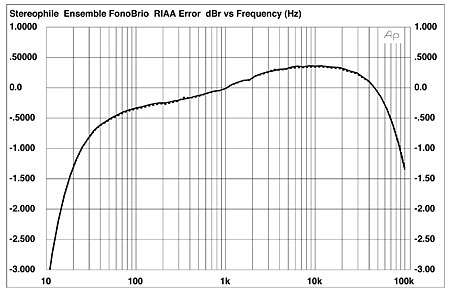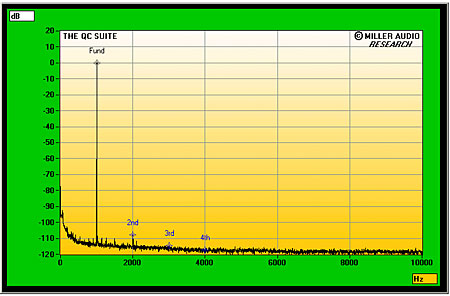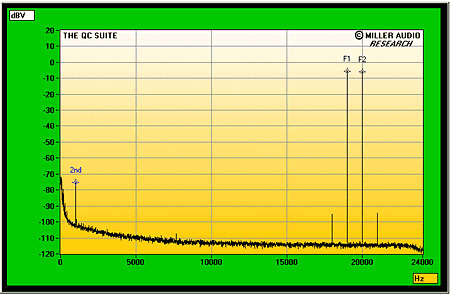| Columns Retired Columns & Blogs |
Ensemble Fonobrio phono preamplifier Measurements
Sidebar 3: Measurements
The Ensemble was noninverting in both MM and MC modes. In MM mode it offered less gain at 1kHz than specified: 37.8dB vs 44dB. The MC mode gains were also correspondingly lower, at 56.4dB ("24dB") and 62.2dB ("30dB"). Its input impedance in MM mode was a high 52k ohms at 1kHz, dropping slightly at 20Hz to 45k ohms and, more significant, to 19k ohms at 20kHz. Set to "51.7 ohms," the MC mode's input impedance was a uniform 77 ohms across the audioband; set to "1k," it measured 1k ohm from 20Hz to 1kHz, rising slightly to 1.5k ohms at 20kHz. Output impedance was to specification at 100 ohms, and DC offset was negligible.
The RIAA response (fig.1) was typified by a gentle rising trend of +0.9dB from the midbass through to the high treble, which should be audible given the wide range affected. I note that BD characterized the Fonobrio as having a tonal balance "slightly lighter than the absolute truth," which is what I would have expected. Channel separation (not shown) was better than 80dB in the midband, decreasing only slightly at the frequency extremes.

Fig.1 Ensemble Fonobrio, RIAA error (right channel dashed, 0.5dB/vertical div.).
The Ensemble was among the quietest phono preamps I have encountered, its wideband signal/noise ratio measuring a superb 85dB in MM mode (ref. 5mV input at 1kHz) and, in MC mode, 76dB ("24dB" ref. 500µV at 1kHz) and 70dB ("30dB"). A-weighting increased these figures even further, to 92.4dB, 80.6dB, and 75dB, respectively.
Overload margins were also excellent, with around 30dB available from 20Hz to 1kHz in MM and the lower-gain MC modes, equivalent to a maximum output voltage of around 10V! The margin dropped to around 15dB at 20kHz in these modes, which is still adequate. Switching the MC mode to "30dB" reduced all the margins by 6dB, as would be expected from the extra 6dB of gain, which will make the 20kHz margin, er, marginal unless a very-low-output MC cartridge is used.
Distortion was very low in level. I had to drive the MM mode with 41mV at 1kHz to raise the spurious harmonics much above the noise floor (fig.2). Even then, the measured THD (true sum of the harmonics) was just 0.005%, with the second harmonic being the highest in level, at just –108dB! Intermodulation distortion was also low (fig.3), the 1kHz difference component (resulting from an equal mix of 19kHz and 20kHz tones at 1V output) lying at –75.3dB (0.017%).

Fig.2 Ensemble Fonobrio, MM mode, spectrum of 1kHz sinewave, DC–1kHz, at 3.16V into 8k ohms (linear frequency scale).

Fig.3 Ensemble Fonobrio, MM mode, HF intermodulation spectrum, DC–24kHz, 19+20kHz at 1V into 8k ohms (linear frequency scale).
Other than its slightly nonflat RIAA equalization, the Ensemble Fonobrio measures superbly well.—John Atkinson
- Log in or register to post comments




































